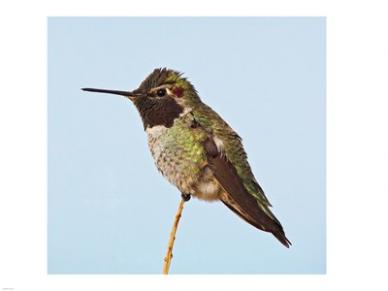Hummingbird First-Aid: Adults
If you find a sick or injured hummingbird on the ground, check and see if the hummingbird is still alive. This is extremely difficult since a hummingbird can enter a sort of hibernation state call torpor when they sleep. It may take as long as twenty to thirty minutes of watching to know for sure if your hummingbird is alive or not. If their eyes are open, and they are breathing, try reaching for the hummingbird to pick him/her up. This may scare them into flying. If attempting to pick up the hummingbird does not work, cup your hands around the hummingbird to pick him/her up. Remember that your little hummingbird is very small, very light, and very delicate. Place the hummingbird in a small box with crumpled up tissue inside and a lid with holes on top before you stand up (in case they struggle and fall out of your hand). The will probably need attention from a veterinarian that is trained in hummingbird care or a trained hummingbird wildlife rehabilitator. The first four (4) hours after injury are critical to hummingbird care.
Take the hummingbird inside to a warm (not hot) location. If the hummingbird starts to open its beak to breathe or its neck is outstretched, it is too hot and they need to be moved to a different location. If the hummingbird is all fluffed up and looks like a cotton ball, he/she is cold and needs to be warmed. To warm up the hummingbird quickly, carefully hold the hummingbird between your thumb and forefinger. Take the hummingbird near a light bulb for warmth. As the hummingbird warms up, his/her feathers will slick down and the eyes will open up. Do not overheat your hummingbird. Make sure the hummingbird is warm before feeding them any nectar.
Offer him/her some homemade nectar. Mix 4 parts water with 1 part sugar. Fill an eyedropper or syringe with the nectar. Carefully place the hummingbird’s beak into the hole of your eyedropper or syringe. Do not squeeze the dropper or syringe to push the nectar into the hummingbird’s mouth as you could drown the hummingbird. If the hummingbird is eating, his/her tongue will be seen moving and bubbles will be seen in the liquid. If the hummingbird gasps or bubbles are seen on the side of the hummingbird’s mouth, stop immediately. Let the hummingbird calm down a bit and try again. If the hummingbird won’t drink, don’t force him/her to do so. Offer the sugar water every 30 minutes until help from trained professional can be reached. If care can not be reached within four (4) hours, consider feeding the hummingbird Nektar-Plus (see warning below).
Nektar-Plus Warning
Nektar-Plus is an excellent hummingbird nectar dietary supplement. It is made in Germany and used in commercial aviaries and zoos around the world because of its balanced nutrition and appropriate amount of protein. However:
- It is NOT suitable for outdoor hummingbird feeders, ever.
- Wild hummingbirds do just fine catching their own bugs and do not need to learn dependency on a feeder.
- It is really expensive
- It has a relatively short expiration date on the bottle
- It needs to be replaced twice a day because it spoils quickly
- It needs to be used with sterilized feeders.
- It is difficult to locate and only available to licensed individuals.
For more information about Nektar-Plus, you can read the package insert in pdf format at: http://www.nekton.de/Gebrauchsanweisungen/NEK-PLUS/ge-pl–e.pdf.
Always keep in mind that there are very stiff laws in North America about holding a hummingbird in captivity.





